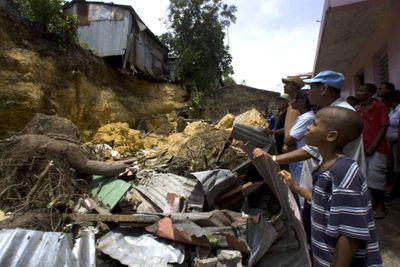New Orleans prepares for Gustav
Threat of hurricane makes life uneasy in Big Easy

NEW ORLEANS – On the eve of Hurricane Katrina’s third anniversary, a nervous New Orleans watched Wednesday as another storm threatened to test everything the city has rebuilt, and officials made preliminary plans to evacuate people, pets and hospitals in an attempt to avoid a Katrina-style chaos.
Forecasters warned that Gustav could grow into a dangerous Category 3 hurricane in the next several days and hit somewhere along a swath of the Gulf Coast from the Florida Panhandle to Texas – with New Orleans smack in the middle.
“I’m panicking,” said Evelyn Fuselier of Chalmette, whose home was submerged in 14 feet of floodwater when Katrina hit. Fuselier said she’s been back in her home one year this month, and called watching Gustav swirl toward the Gulf of Mexico indescribable. “I keep thinking, ‘Did the corps fix the levees?’ ‘Is my house going to flood again?’ … ‘’Am I going to have to go through all this again?’ ”
Taking no chances, city officials began preliminary planning to evacuate and lock down the city in hopes of avoiding the catastrophe that followed the 2005 storm. Mayor Ray Nagin planned to leave the Democratic National Convention in Denver to return home for the preparations, as did U.S. Sen. Mary Landrieu. Gov. Bobby Jindal declared a state of emergency to lay the groundwork for federal assistance, and put 3,000 National Guard troops on standby.
If a Category 3 or stronger hurricane comes within 60 hours of the city, New Orleans plans to institute a mandatory evacuation order. Unlike Katrina, there will be no massive shelter at the Superdome, a plan designed to encourage residents to leave. Instead, the state has arranged for buses and trains to take people to safety.
It was unclear what would happen to stragglers. Jerry Sneed, the city’s emergency preparedness director, said officials are ready to move about 30,000 people. Nearly 8,000 people had signed up for transportation help by late Wednesday.
Katrina struck New Orleans on Aug. 29, 2005, and its storm surge blasted through the levees that protect the city. Eighty percent of the city was flooded.
Though pockets of New Orleans are well on the way to recovery, many neighborhoods have struggled to recover. Many residents still live in temporary trailers, and shuttered homes still bear the ‘X’ that was painted to help rescue teams looking for the dead.
Many people never returned, and the city’s population, around 310,000 people, is roughly two-thirds what it was before the storm, though estimates vary wildly.
Since the storm, the Army Corps of Engineers has spent billions of dollars to improve the levee system, but because of two quiet hurricane seasons, the flood walls have never been tested. Floodgates have been installed on drainage canals to stop any storm surge from entering the city, and levees have been raised and in many places strengthened with concrete.